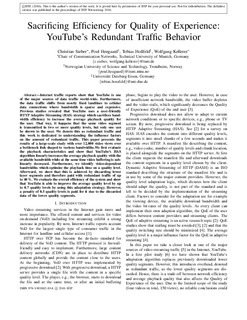Sacrificing Efficiency for Quality of Experience: YouTube’s Redundant Traffic Behavior
Chapter
Accepted version
Permanent lenke
http://hdl.handle.net/11250/2440454Utgivelsesdato
2016Metadata
Vis full innførselSamlinger
Originalversjon
"YouTube Can Do Better: Getting the Most Out of Video Adaptation", Teletraffic Congress (ITC 28) 2016 28th International, vol. 03, pp. 7-12, 2016. 10.1109/IFIPNetworking.2016.7497231Sammendrag
Internet traffic reports show that YouTube is one of the major sources of data traffic world-wide. Furthermore, the data traffic shifts from mostly fixed landlines to cellular data connections where bandwidth is sparse and expensive. Previous studies revealed that YouTube uses a user-friendly HTTP Adaptive Streaming (HAS) strategy which sacrifices bandwidth efficiency to increase the average playback quality for the user. That way, it happens that the same video segment is transmitted in two or more quality levels, but only one can be shown to the user. We denote this as redundant traffic and this work is dedicated to understanding the influence factors on the amount of redundant traffic. This paper presents the results of a large-scale study with over 12,000 video views over a bottleneck link shaped to various bandwidths.We first evaluate the playback characteristics and show that YouTube’s HAS algorithm linearly increases the average playback quality with the available bandwidth while at the same time video buffering is sublinearly decreased. Furthermore, we identify video-dependent bandwidths which optimize the playback time on a quality level. Afterward, we show that this is achieved by discarding lower layer segments and therefore paid with redundant traffic of up to 40 %. We evaluate the overall efficiency of the system and show that YouTube is able to improve the average quality level by up to 0.7 quality levels by using this adaptation strategy. However, a penalty of 0.5 quality levels is paid for it due to the discarded data of the lower quality segments.
